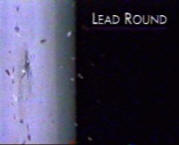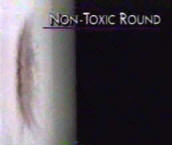‘Green’ Bullets: For the Ethically and Environmentally Conscious Hunter?
It’s amazing to me (but not surprising) that industries whose practices are not only notoriously cruel and often superfluous, but blatantly damaging to increasingly fragile ecosystems are able to advertise that they’re ‘green’. Like the greenwashing of furs, coal, cars, and more - Julian reports on a movement within the hunting community towards ‘green’ bullets. We learned a lot about the phenomenon of greenwashing in the book “Toxic Sludge is Good For You”. And we must ask - what’s next? ‘Green’ bombs?
‘Green’ Bullets: For the Ethically and Environmentally Conscious Hunter? by Julian Dezorzi
About a month ago, The Discerning Brute jokingly awarded the Canadian Fur Council’s “Fur is Green” campaign with the “greenwashing award of the decade” (see entry here). The CFC certainly struck a chord with people who know anything about the toxic, cruel, and unnecessary fur industry.
Not to be outdone, some hunters have decided to follow suit and go ‘green’ in the name of ‘environmentalism’ by switching to copper-based ammunition rather than the more often used, highly toxic, and (of course) cheaper, lead-based bullet alternatives. Now, not only will our environment be protected from the adverse effects of all those toxic lead bullets, but the animals on the receiving end of the slug would be thrilled to know that the person who shot them from a hundred yards away was doing their part to protect nature from – you got it - something that might kill. Or as one of our ‘environmentalist’ hunter friends, Phillip Loughlin, who, “made a choice he knew would brand him as an outsider with many of his fellow hunters,” rationalizes: "I believe that we need to do a little bit to take care of the rest of the habitat and the environment -- not just what we want to shoot out of it."

Have you ever seen what a copper mine looks like today? And what copper looked like in the days of the gold rush? Watch this short video. Or how about the effects that mining for the highly depleted copper metal that will go into making these so-called ‘green’ bullets? It is unlikely these bullets are being made from recycled copper, and peak levels are exceeded, making copper mining much more costly and hazardous.
[youtube="http://www.youtube.com/watch?v=PfAQktktGgQ&feature=player_embedded"]
I am not claiming to be perfect – after all, I am typing on a computer with copper in it, knowing it was built somewhere in Asia and it’s construction is causing cancer. This article, however, is about the greenwashing of bullets used to kill animals. Let’s turn our attention back to the article and see how hunters are beginning to warm up to the idea of going ‘green’.
What exactly is ‘green’ about the killing of thousands of animals a year? Population control? O, the old population control rationalization. This is often the argument that hunters and rifle aficionados use to justify their desire to bag the ‘big’ buck, go on the canned hunt, and get the trophy that will sit atop their mantle piece as a testament of their skillful manhood rooted in some primal fantasy. Although there are numerous reports that suggest that population control does work in some instances, these studies are countered by numerous studies suggesting otherwise. (See here and here, for example).

Then there’s the effects that hunting has upon land management within many of the private lands that are deforested in order to create a ‘hunter-friendly environment’, devastating even more forest systems and forcing animals to become ‘pests’ as they seek out food in ever-expanding residential areas and farmlands.
The main argument that this article is attempting to put forward is that lead-based bullets are hazardous to the health of the humans who will eventually consume the animals they kill. The article cites a study by the Minnesota Department of Natural Resources “which found that when lead bullets explode inside an animal, imperceptible particles of the metal can infect meat up to a foot and a half away from the bullet wound -- farther than previously thought” or, as Dr. William Cornatzer, a dermatologist and falconer, after testing a number of venison samples and finding that “about half of the 100 samples -- all shot by hunters -- tested positive for lead,” points out that "the scary thing is these fragments are almost like dust in the meat. They're not like metal fragments you would feel when you bite down."
The implicit megalomaniacal assumption made by this article is ultimately just another example of the speciesism that is part of the dominant social and cultural fabric. This assumption is that human health, safety and lives are intrinsically more valuable than the lives of other animals and the natural environment. Never once does the article acknowledge the ramifications that hunting has upon the habitats that house the thousands of animals that are hunted, for sport and otherwise, each year.


For the majority of us, hunting is not necessary for survival. Most of us can thrive on a plant-based diet. Of course subsistence hunters are not the problem here. I’m not asking the Inuit, Aboriginal or Uru to go vegan. And subsistence hunting is often more humane than farming animals (so if you cringe at the idea of hunting, yet salivate for cheap bacon, it’s time to come to terms with factory farming). However, sport hunters will often invoke the romantic life-or-death imagery of subsistence hunting in order to justify their sport.
Although the article could conceivably be lauded for the concern it addresses for both human and the natural environment’s well-being through switching to these ‘green’ bullets (arguments that, as I have briefly shown, are highly problematic and belie the actual effects that hunting and mining have upon the natural world) it must equally, and perhaps even more forcibly, be attacked on what it fails to address, namely, the total disregard for the safety and health for the actual animals that are being shot and shot at by both lead and the copper alternatives. For example, what are consequences that lead-poisoning has upon the bodies and cognitive systems of the animals that often ‘get away’ wounded? Such oversights and miss-acknowledgments are sadly the norm. Indeed, this article has striking similarities and echoes the lack and total disregard for addressing such questions in the news media’s coverage of the USDA’s unprecedented recall of 164 million pounds (!) of meat that happened last year-- a recall that came to light as a result of a number of whistle-blower videos showing ‘downer cows’ and reports surrounding the egregious and just plain disgusting treatment, handling and killing of cattle and other factory-farmed livestock.
While new reports came in everyday, I found myself searching in vain for at least one report from the mainstream media outlets that condemned and/or attacked the actual perpetrators of these acts to no avail.

I am not claiming that people’s health should not be a nation’s number one concern, nor am I arguing that the weight and severity of these events should not have been reported. Quite the contrary! These reports and the videos that triggered them are essential to informing the nation of the horrendous acts being committed everyday by the meat and dairy industries, as well as the hunting industry. It is of utmost importance for people to be aware and (hopefully) concerned with what they are putting into their bodies for daily sustenance and there must be more oversight and regulations put into place in order to protect not only humans, but animals as well.
This ‘green BULLets’ story is just a part of the ‘green-ification’ agenda that all industries are trying to cash-in on. The absurd notion that something as destructive as ammunition can be ‘green’ is not only deceptive but is a complete misrepresentation of the facts. Being ‘green’ means undertaking actions in order to live within a sustainable world that respects the fact that environmental resources are scarce. It is an acknowledgement that our actions have effects upon the world we live in and an attempt to offset, reduce, minimize, or even reverse the impact that these actions have upon the earth and its resources.
There is nothing sustainable about the hunting industry. In fact it’s quite the opposite. The amount of energy it takes to extract the copper it will take to support this $1.08 billion a year industry, the environmental ramifications that the deforestation measures that are used in order to accommodate sport hunting, and the imbalances to the populations of animals hunted for sport are just a few examples of the consequences that this industry has upon the natural environment and a testament to its lack of sustainability.
----
The Discerning Brute’s featured contributor, Julian Dezorzi, is a recent grad-school graduate. Julian De Zorzi is an activist and aspiring writer-filmmaker who lives in Brooklyn.
.
